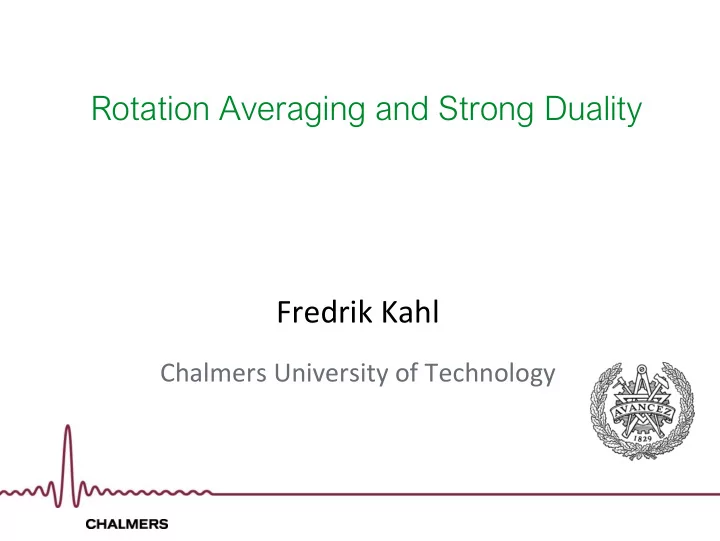

Rotation Averaging and Strong Duality Fredrik Kahl Chalmers University of Technology
Collaborators Carl Olsson Anders Eriksson Viktor Larsson Tat-Jun Chin Chalmers/Lund University of ETH Zurich University of Queensland Adelaide
Structure from Motion Visual Navigation Visual Localization
Outline Main topic: Semidefinite relaxations for optimization over SO(3) - Introduction - Problem formulation and examples - Analysis: Relaxations, tightness and extreme points - In depth: Rotation averaging - Conclusions
Rotation averaging - Goal: Recover camera poses given relative pairwise measurements 1 5 2 3 4 6
Hand-eye calibration
The Chordal distance - Defined as the Euclidean distance in the embedding space, - Equivalent to:
Registration of points, lines and planes
Problem formulation Let where each .
How to overcome the problem of non-convexity? - One idea: Relax some constraints and solve relaxed problem - How to relax? 1. Linearize 2. Convexify - Tightness: When is the solution to the original and relaxed problem the same?
Linearization - Longuet-Higgins, 1981 - Stefanovic, 1973 - Thompson, 1959 - Chasles, 1855 - Hesse, 1863 - Hauck, 1883
Convexification - Quasi-convexity Q. Ke, T. Kanade, PAMI 2007 F. Kahl, R. Hartley, PAMI 2008 - Semidefinite relaxations F. Kahl, D. Henrion, IJCV 2007 C. Aholt, S. Agarwal, R. Thomas, ECCV 2012
Estimating a single rotation
Estimating a single rotation Original problem Relaxed problem - Is the relaxation always tight? - Are all minimizers Λ * of the convex relaxation rank one?
Empirical result for 1000 random Q :s
Sums of squares polynomials Multi-variate polynomial p(r) is a sums of squares (SOS) if
The SO(3) -variety
A theorem by Blekherman et al , J. Amer. Math. Soc., 2016
Extreme points Original problem Relaxed problem - Are all minimizers Λ * of the convex relaxation rank one?
Empirical result for 1000 random Q :s for SO(3)xSO(3)
Rotation averaging in Structure from Motion
Estimate camera poses A possible pipeline: Estimate relative epipolar geometries (5-point algorithm) 1. Given relative rotations, estimate absolute rotations 2. Compute camera positions and 3D points ( L -optimization) 3. ∞
Rotation averaging - Goal: Recover camera poses given relative pairwise measurements 1 5 2 3 4 6
Literature - Quaternions: V.M. Govindu, CVPR 2001 - Single rotation estimation: R.I. Hartley, J. Trumpf, Y. Dai and H. Li, IJCV 2013 - Duality: A. Singer, Applied and Computational Harmonic Analysis, 2011 J. Fredriksson, C. Olsson, ACCV 2012 L. Carlone, D.M. Rosen, G. Calafiore, J.J. Leonard, F. Dellaert, IROS 2015 - Analysis: K. Wilson, D. Bindel and N. Snavely, ECCV 2016
Rotation averaging - Problem formulation Graph (V,E) where V = camera poses and E = relative rotations 1 5 2 3 4 6
Rotation averaging - Problem formulation Graph (V,E) where V = camera poses and E = relative rotations
Rotation averaging - Non-convex problem Ground truth Local minimum - Three local minima
Optimization - Background - Well established theory on duality for convex optimization - Duality is at the core of many existing optimization algorithms - Less understood about the non-convex case - Aims - Can we obtain guarantees of global optimality? - How to design efficient optimization algorithms?
Duality
Duality - Lagrangian: - Dual function:
Duality Primal problem Dual problem (D) (P) Since (D) is a relaxation of (P), we have
Primal and dual rotation averaging Primal problem (P) Lagrangian Dual problem (D)
Concurrent work D. Cifuentes, S. Agarwal, P. Parrilo, R. Thomas, ”On the Local Stability of Semidefinite Relaxations”, Arxiv 2017
Main Result Note : Any local minimizer that fulfills this error bound will be global!
Corollaries Example:
Corollaries Example: For complete graphs,
Experiments
Further results - Full analysis with proofs - New primal-dual algorithm - More experimental results A. Eriksson, C. Olsson, F. Kahl, T.J. Chin, to appear PAMI 2019
Conclusions - Strong duality (= zero duality gap) for rotatation averaging provided bounded noise levels - Practically useful sufficient condition for global optimality - Analysis also leads to efficient algorithm
Future work - Robust cost functions, e.g., L1 with IRLS - Further analysis – when is duality gap zero and for what problems?
Point averaging
Visual localization High-quality night-time images Seasonal changes, (sub)urban Seasonal changes, urban; Low-quality night-time images www.visuallocalization.net Benchmark challenge and workshop at CVPR 2019
Estimating a single rotation J. Briales and J. Gonzalez-Jimenez, CVPR 2017
something else here A. Eriksson, C. Olsson, F. Kahl, T.-J. Chin Rotation Averaging and Strong Duality, CVPR 2018
Recommend
More recommend